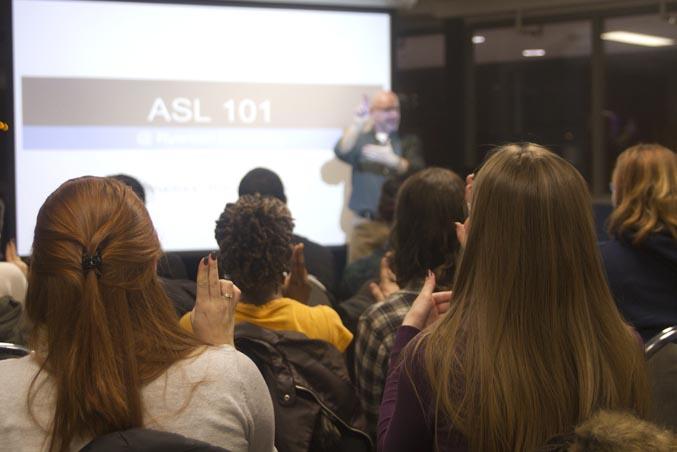By Victoria Shariati
The American Sign Language (ASL) course at Ryerson employs a “no-voice” method in order to teach students how to communicate non-verbally.
On Monday, I attended the beginner’s session. Right off the bat, I knew it would be difficult to communicate with the instructor, Ronald Dans, given the fact that he was Deaf and I had yet to learn any sign language.
To most people, the thought of taking a “no-voice” course is daunting. Initially, it was. Dans made it clear, albeit in his typical joking manner, that those of us who spoke would be asked to leave the class.
For Dana Dwaik, a Journalism major, the unique way in which the class is taught interests her, rather than scares her away.
“I like how we don’t talk. It’s different from other classes,” Dwaik says. I spoke to Dans before the class began by typing my questions on a laptop (which he later poked fun at for being old), and he would respond by writing his answers on my notepad.
“I’m from Toronto. I used to work at CHS [Canadian Hearing Society] but I’m a Deaf interpreter for Ontario Interpreting Services,” Writes Dans, who is a faculty member at George Brown College in the Deaf Upgrading Program.
“I love to teach hearing people so they can communicate with the Deaf Community,” he writes. He tells me he’s been teaching for 25 years, three of which were at Ryerson.
The class begins, and approximately 35 students (none of whom are Deaf) file in. Despite the clear communication barrier, we’re still able to understand Dans, and he makes everyone laugh by miming jokes. He later tells me that the class originally began with eight students, but tonight, it was at capacity.
American Sign Language is not universal- in fact, it is merely one of over 200 sign languages. Also, as Dans informs us, it’s important to avoid chewing gum in class, since facial expressions are necessary for ASL communication.
Immediately, the instructor is sure to engage every single one of the students. After we learn how to sign our names, greetings, and to exchange pleasantries, he then asks people to walk up to the laptop and type their names. The rest of the class then signs it. If we’re learning about colours or patterns, he asks those with the relevant clothing to stand up for all to see.
Dans teaches us by pointing to certain things around the room, such as a table, or someone’s backpack, and shows us the corresponding sign. The students are then asked to get into groups, where we practice new concepts. We study the alphabet, numbers, colours, and patterns.
After about 15 minutes of learning names (and the obligatory middle finger jokes that accompany learning sign language), most of the class has a solid understanding of how to spell.
Despite the fact that this is the first ASL course for Tenzin Dhadon, an English major, she makes a strong effort to remember everything we’re taught.
“It’s very informative, and somewhat easy to follow along with for a beginner. I’m a complete newbie,” Dhadon says. “I think it’s a really important skill to have. It’s like learning a foreign language.”
Dhadon’s sentiments are not uncommon. Aisling McGeagh, an Arts and Contemporary Studies student, mentions how learning sign language can give you a step up in the work force. For her, since she hopes to work with disabled children, it’s even necessary.
“A lot of people in classrooms don’t get taught to work with children with disabilities. It’s sad,” McGeagh says.
When asked about what he hopes the hearing students will take away from the course, Dans is clear with his answer.
“They can communicate with the Deaf community,” he writes. “Some day, they might work with Deaf clients or Deaf employees.”
He then points at what is projected on the screen. It reads, “12 Reasons to Learn ASL”. The last reason is, “Get to know some wonderful people in the Deaf community.”
Later, he tells me that his best hope for the advancement of the Deaf community is through the education of those who can hear.
“The vast majority of the Deaf community do not wish to be hearing but want the hearing world to accept them, understand them,” writes Dans. “We simply want to be part of the narrative.”
The beginner’s and intermediate classes take place in the Student Centre on Mondays, from 6-8PM. For $30, anyone can enrol in the semester-long sign language course.










Leave a Reply